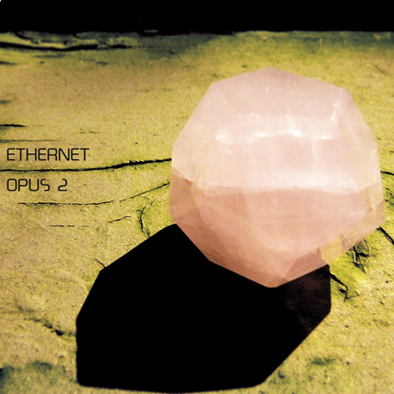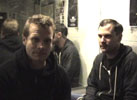Ethernet, "Opus 2"

To be frank, I am somewhat astonished that I like this album so much, as the combination of muted house beats and synth-based ambient music seemed like it could not be anything but lethally boring at this point, as the ship has definitely sailed on that particular niche.  However, it is impossible to overstate the importance of skilled execution.  In the wrong hands, great ideas are doomed, while the right artist can turn something seemingly dubious into something wonderful.  In this case, Tim Gray, recording as Ethernet, is the right artist.  It is hard to isolate exactly where all of his talents lie, but the most obvious one is that Tim is a truly excellent producer.
This second Ethernet album for Kranky is a curious continuation of an ongoing quest to détourné dance music rhythms into hypnotic, inward-reaching ambiance.  There are many, many ways for such an experiment to go badly awry, but Tim Gray deftly sidesteps nearly all potential perils to find a near-perfect balance between minimal techno and lush, softly hissing dreamscapes.
Gray's production genius is evident from the first notes of "Monarch," as the warm synth tones gently blur together and undulate like a thick mist.  The actual music seems deceptively simple, as the song is essentially built upon a few swelling chords, a slowly throbbing bass, and a fragmented, delay-heavy melody, but Tim transforms those components into something that feels alive, oceanic, and utterly absorbing.  This is the sort of song that warrants descriptors like "amniotic" and "womblike" and the remaining five pieces do not stray far from that template at all.
Ethernet's other area of expertise is a bit more vague, but it definitely originates from his in-depth studies of meditation, trances, and brainwaves: this is actually quite a hypnotic album.  Most of that is probably due to the slow-motion pulse of the kick drum, but it goes much deeper than that, as the omnipresent hiss and swelling, swaying chords seem to effectively mimic relaxed inhalation and exhalation. Aside from the production, that feat of illusion might be this album's greatest strength, as everything is so fluid and organic-sounding that it is very easy to forget that this is a laboriously constructed, multi-layered work that was painstakingly perfected a man in a room somewhere.  Instead, it sounds  like something spontaneous that just flowed out of my speakers.
I am a bit conflicted about most apparent flaws of Opus 2, as they could just as easily be interpreted as challenges that Gray managed to overcome.  Naturally, I was not thrilled to hear a four-on-the-floor thump in every single song and the rare appearance of cymbals was a bit distracting, but that omnipresent pulse seemed absolutely necessary in maintaining the album's dreamlike reverie and continuity.  I will say that I found the beat most effective when it was stealthily buried, as it is in "Cubed Suns,"but is hard to imagine the album working as effectively without that constant throb.  Also, some of the individual songs can drag a bit (particularly the lengthy "Pleroma") or get too pastoral in places, but they generally work well within the context of the entire album and there is enough unpredictability and dissonance to mostly keep things fairly compelling.  I suspect this album could have been massive if it had been released in the late '90s, but it is still a surprisingly enjoyable anomaly in 2012 that fits quite comfortably within the Kranky aesthetic (Loscil being the closest kindred spirit).
 




